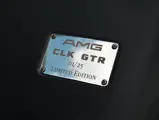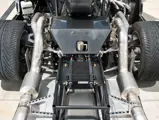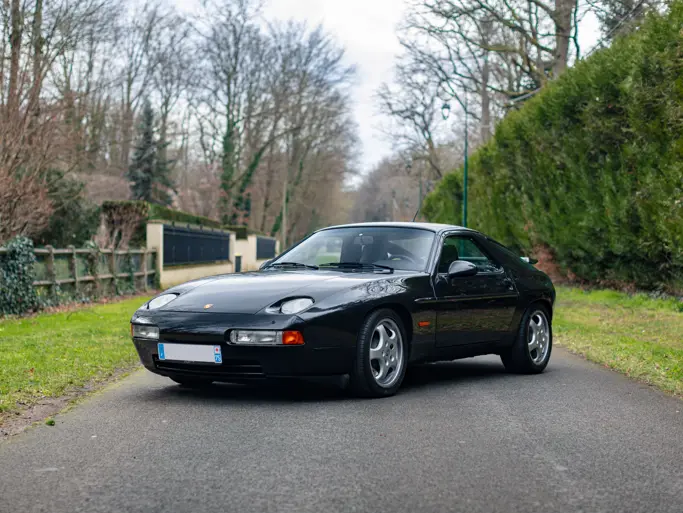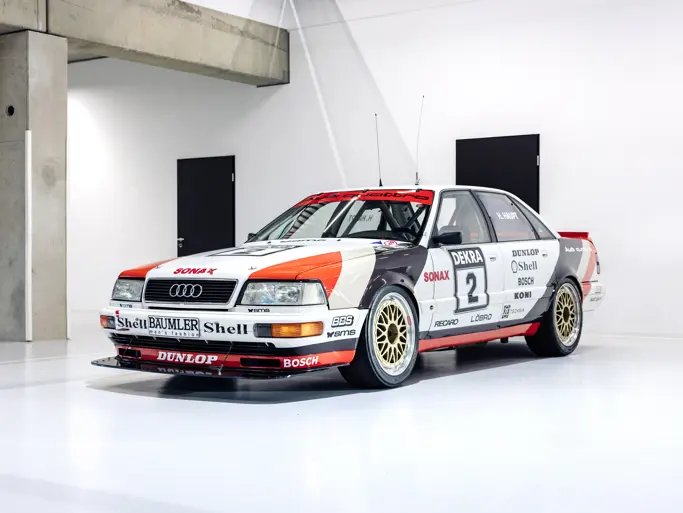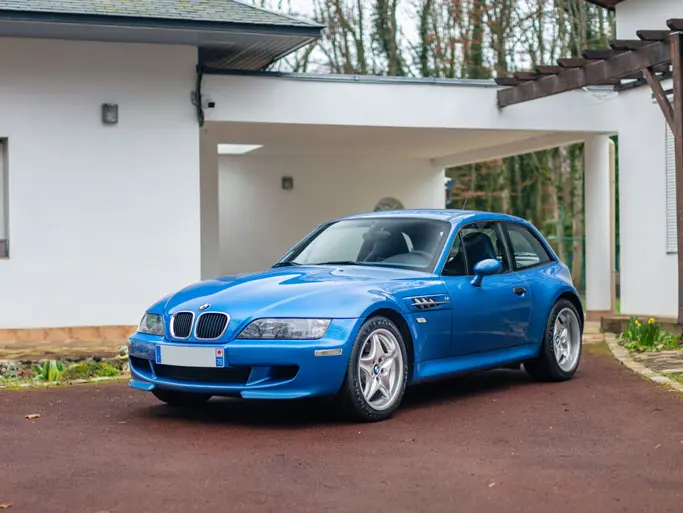Monterey 2012
1998 Mercedes-Benz CLK GTR
{{lr.item.text}}
$1,100,000 USD | Sold
 | Monterey, California
| Monterey, California
{{internetCurrentBid}}
{{internetTimeLeft}}

720 bhp, 7.3-liter dual overhead cam naturally aspirated V-12 engine, six-speed sequential manual gearbox with paddle-shift operation, double wishbone with push-rod, actuated coil spring with shock absorber front and rear suspension, and four-wheel vented carbon fiber disc brakes with anti-lock braking system. Wheelbase: 105.1"
• The first of only 25 built
• Major performance upgrades by AMG partner H.W.A. to the most desirable “SuperSport” 720 bhp, 7.3-liter V-12 specification
• Only 1,335 miles from new
• Numerous extras, including luggage
AMG
AMG Motorenbau und Entwicklungsgesellschaft was founded by former Mercedes engineers, Hans-Werner Aufrecht and Erhard Melcher, in the late-1960s, near Stuttgart. The company’s acronym was derived from Mr. Aufrecht and Mr. Melcher’s names, as well as the town of Grossaspach, where they were headquartered.
After earning considerable respect tuning and racing Mercedes’ durable engines, most notably in the European Touring Car Championship, AMG became an official corporate partner. Heretofore, the relationship between the two had been rather informal, with AMG supplying aftermarket cosmetic and performance upgrades for more discerning, performance-oriented drivers.
For the 1988 DTM season, however, the new Mercedes-Benz AMG team unveiled the sensational W201 touring race cars. The importance of AMG to Mercedes consequently increased, resulting in the acquisition of the tuning shop by the three-pointed star and the production of a limited number of AMG 190E 3.2 road cars. At $90,000, the diminutive sedans carried an S-Class price tag and were capable of Autobahn-worthy speeds in excess of 250 km/h. This project evolved into the highly successful C-Class DTM cars that earned an impressive 84 wins in the 1990s. Such was the fabled start of AMG’s entrance into production sports car manufacturing.
FIA GT and the CLK GTR
By the mid- to late-1990s, however, there was ever-growing interest from Mercedes-Benz and Porsche to return to an ultra-exclusive form of racing, featuring homologated race cars in the tradition of the great Gran Turismo racers of yesteryear. The result was the FIA GT Championship, which commenced in 1997 to great fanfare and eager enthusiasm. Mercedes-Benz AMG would have to enter the top-level GT1 class and compete head-on with the astounding Porsche 911 GT1 and BMW-powered McLaren F1. In this sense, the upper echelon of FIA GT racing was essentially a battle between Germany’s top three automotive competitors. In order to participate in FIA GT, however, 25 homologated road cars had to be produced by each manufacturer. Not surprisingly, these limited production cars were instantly collectible and highly sought-after.
The task was a monumental one; AMG had only four months to design, build, and test a viable and competitive race car and its road-going brother, with the intent of winning and doing so repeatedly. As there is no replacement for simple pencil and paper, the original designs were crafted as such and then perfected through the use of Computer Aided Design (CAD) before being translated into 1/5 scale three-dimensional clay models. Early in 1997, the proposed engine for the CLK GTR, a 6.9-liter V-12, was already undergoing rigorous testing from AMG’s expert engineers.
By March of the same year, the other two components of AMG’s three-pronged racing campaign were in full swing: the American CART series kicked off in Homestead, Florida and the new McLaren-Mercedes MP412 made its debut at the Formula One Grand Prix of Melbourne, where its victory marked the first win of a Silver Arrow since 1955.
AMG, however, saved the best for last, as its mechanics worked round the clock on their most impressive product to date. Finally, only 128 days after the first sketches were conceived on paper, the very first CLK GTR took to the track in Spain.
Mercedes veteran Bern Schneider, along with AMG’s young gun, Alexander Wurz, tested the car with extremely successful results. Norbert Haug immediately called Hans-Werner Aufrecht from the pits at the Brazilian Grand Prix to see how testing was proceeding in Spain. Mr. Aufrecht, grinning, understated the car’s performance and said, “Er fährt…sieht gut aus” (It runs…and looks good). Needless to say, the project was green lighted by Mercedes’ board of directors. AMG had declared all-out war that the likes of which the motorsport world had never seen.
The CLK GTR did more than just run. After only four months, AMG had produced two race-ready CLKs and one homologated road version, with 300 prospective buyers eagerly waiting in line. This first CLK GTR for the streets was presented to FIA Head of Constructors Gabriel Katringer on Monday, April 1, 1997, only six days before its race-ready brethren would make their debut at Germany’s home track, the Hockenheimring. Bernd Schneider not only picked up fastest lap honors but also pole position in the CLK GTR’s maiden voyage. After a slightly staggered start to the season, the new AMG supercars reigned victorious at the A-1 Ring, Suzuka, Donington, Sebring, and Laguna Seca, taking the team championship back home to Affalterbach, while Schneider secured the Driver’s Championship.
For 1998, however, the CLK GTR saw rather limited use, as the 630 horsepower behemoth was being fazed out by its descendent, the CLK LM, which was conceived with victory with the 24 Hours of Le Mans in mind. Race regulations and conditions at Le Mans required that Mercedes’ entry receive certain upgrades in preparation for the world’s most famous endurance race. Unfortunately, the race-proven M120 V-12 was replaced by another naturally aspirated engine, the M119 V-8. Surprisingly, the V-8 produced equal amounts of horsepower and was believed to be better suited for long-distance racing. Additional aerodynamic modifications were made in the way of a lowered roofline and nose and redesigned air intakes. Ironically, the two CLK LMs retired early in the race due to engine failure.
AMG returned to the FIA GT series unfazed, however, scoring six 1-2 finishes and securing the team championship, as well as driver’s championship for Ricardo Zonta and seasoned Mercedes racing driver Klaus Ludwig. In 1999, the FIA GT1 class was cancelled due to lack of interest from Mercedes’ competitors. As a result, Mercedes set about designing and building its CLR, a car that owed much of its design to the CLK GTR but was unrestricted by homologation requirements. Its debut at Le Mans would prove equally dramatic as Mark Webber’s #4 car became airborne due to a rise in elevation on the Mulsanne straight.
Homologation
McLaren’s entrance into the FIA GT1 class required that its already outstanding McLaren F1 road car be outfitted in racing trim. By contrast, the AMG solution to homologation was quite the opposite. Instead of building a race car from an existing sports car, AMG set about creating an all new GT1 contender whose homologated variants were essentially nothing more than road going race cars.
As per FIA regulations, Mercedes ensured construction of 25 of these legendary machines, typically painted the historical German racing color: silver. AMG produced every car in Affalterbach, Germany with minimal additional creature comforts, ensuring that each owner was delivered the next best thing to the race-proven CLK GTRs. Up front, next to the inboard suspension and radiator system, rested an air conditioning unit, while an Antilock Braking System was added for additional safety. The obvious lack of trunk space was slightly alleviated with two small storage compartments under each upward swinging door, while interior comfort was improved with leather appointments. Although no major aerodynamic changes were made, the car’s rear wing was sculpted to fit the body more smoothly, and the front air dam was also redesigned. Unlike the McLaren F1, the CLK GTR behaved like a bona fide race car on the street. Gear changes were lightning-quick, thanks to a paddle-operated six-speed sequential manual gearbox lifted directly from the GT1 cars. The mid-mounted 6.9-liter V-12 rested directly behind the driver, producing an utterly raw and menacing exhaust note. With the exception of four round headlamps and distinctive taillights, the CLK GTR shared little with its concurrently introduced passenger car, the Mercedes-Benz CLK.
H.W.A.
This particular CLK GTR is arguably one of the two most desirable examples. Of the 25 road-going CLK GTRs produced, two were built and heavily modified by AMG’s sister company, H.W.A. GmbH, so named for its president and AMG co-founder, Hans-Werner Aufrecht. H.W.A. did the unthinkable, by replacing the CLK’s already potent 6.9-liter V-12 with Mercedes’ newer and more powerful 7.3-liter V-12 engine, producing a blistering 720 horsepower.
This specific car is number 1 of 25, as evidenced by its commemorative plaque. It received SuperSport badging from H.W.A., indicative of its status as the most exclusive and powerful CLK GTR ever built. This is the only car of its kind fitted with a non-retrofitted factory power kit, delivered by AMG. With only 1,335 accident-free original miles, car #1 is an absolutely outstanding example. It remains in immaculate condition, as it has been properly maintained and tuned since its original construction.
In addition to this specific SuperSport, the other H.W.A. example, #17, was originally painted red with a tan interior. It was later repainted silver. Five other roadster variants were also produced but did not receive the 100 horsepower upgrades.
Also of note, this CLK GTR is offered with numerous additional items, including two pieces of luggage, a first aid kit, a Mercedes-Benz tire pump, battery charger, and spare tire inflator. Several of these pieces are also marked “1 of 25,” further confirming this car’s production number. Additionally, the car comes with a spare exhaust manifold and two smaller pouches containing everything from flares to white gloves.
As presented, the CLK GTR SuperSport is the closest a road-going car will ever come to its race-ready sibling. Its performance figures are downright mind-blowing; surely even Steve McQueen would have pulled over on the Mulsanne straight. Considering its status as one of the rarest German sports racing cars ever produced, it holds true to the valued traditions of homologated GT racing and, in spite of its 21st century technology, has solidified its place in history as a classic among classics.







